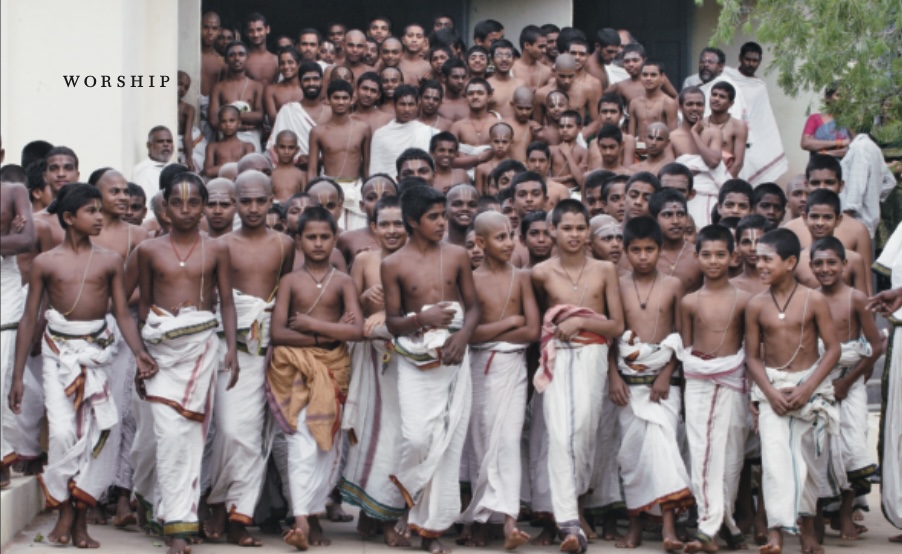G.K. Ramamurthy, 46, began his priestly studies in 1967 at the famous Sri Venkateshwara Veda Pathashala in Dharmagiri near Tirumala. After graduating in 1982, he stayed on as a teacher. Since 1992 he has been head principal of the illustrious institution, which is considered one of the finest priest-training centers in India. Hinduism Today correspondent Rajiv Malik had the opportunity to speak with the distinguished acharya (teacher) when he visited the school grounds. Here are some excerpts.
How many students are being taught here and what do they study? We now have 26 teachers instructing 400 students in 14 subjects. Two thousand priests have graduated from this institution. We teach the entire gamut of temple rituals. The students here live on the premises. This institution is more like an ashram.
There are various Agamas in our ancient literature, but we teach only three in this pathashala. These are the Vaikhansa Agama, the Pancharatra Agama and the Saiva Agama. The Pancharatra Agama is used for worshipping Goddess Padmavati. The Vaikhansa Agama is known as the agama of Lord Venkateshwara. Lord Bala Ji is worshipped only through the Vaikhanasa Agama. In Vaikhansa Agama training, we now have 175 students. The Saiva Agamas are meant for Siva temples only. Each student is free to choose the agama he wants to learn, but he is restricted to the study of that agama only throughout his training here.
Does the school curriculum include education on subjects other than those directly related to priest training? We don’t teach philosophy, although the students learn all about worship and its practice. This cultivation of personal devotion is fundamental to all of the other training. The students are also taught astrology, Sanskrit and the Dharmashastra (a famous ancient Hindu scripture delineating civil code, social law and moral principle). Students are offered a choice of two courses. The twelve-year course is quite extensive. It covers priest training as well as a deeper study of the Vedas. The eight-year course is specifically designed to prepare students to become fully trained temple priests.
Has the ancient pathashala system changed in any way to adapt to modern times? Many years ago, we only taught priests for the Balaji Temple. When it was decided to expand the priest-training program, this pathashala began to grow rapidly. Also, a few years back English was introduced here as a part of the curriculum. We are becoming increasingly aware of the importance of English as a second language. Specifically, we are teaching the students to read, write and speak in English.
Do graduates of the school generally prefer to work at the Balaji Temple in Tirumala as a first option, or do they sometimes choose to work elsewhere? There is no compulsion for a priest to join this particular temple after completing his study. A graduate is free to work at any temple he chooses. The average salary of a priest at the Balaji Temple is US $300 per month, which is considered very good here in this country.
In India there are many temples. Priests who aren’t recruited here can easily get jobs elsewhere. The demand for priests is greater than the supply. Today, priests who have been trained in this pathashala are happily settled all around the world.
There are three working shifts of priests per day in the Balaji temple. Each shift requires 20 to 30 priests. So every day, between 60 and 90 qualified priests are required just to keep the temple functioning at a basic level. During festivals, many more are needed. So, the need here at home is great.
Are there any special qualifications that must be met by young men who aspire to be priests in Tirumala? A priest at the Balaji temple in Tirumala must be born the son of a Vaikhansa Archakar, a priest who is himself fully trained in the Vaikhansa Agama. He must also be taught certain priestly samskaras (subconscious impressions) while still in the mother’s womb. This is accomplished through a ritual called the Vishnu Bali. Vaikhansa Archakars are also sometimes referred to as Adi Vaishnavas.
What are the plans for the future of the school? At present, we have 24 classrooms in the pathashala. We plan to construct 45 more. All of the classrooms are modern, as are the living facilities. We also plan to construct a huge library and an ultra-modern kitchen. Work on all of these projects will be starting in the very near future.
Are there any dangers or hazards associated with living in the forest like this? The Vedic pathashala is also located on holy ground. This is what keeps us safe, even though we are in the midst of a dense forest. It is most interesting to note that never in the history of the pathashala have any of our students gotten injured or even suffered from a snake bite, even though in the forest area like this, there are many poisonous snakes. Such is the grace of Lord Balaji here in this sacred place. There have even been some instances where our students suffered from snake bites in their own native villages where the probability of receiving such injuries was much less. One of our students died from such a snake bite at his home after studying here for a number of years with no such problem of this sort at all.
Is the school enrollment expanding? About 30 to 35 students graduate every year. However, the ratio of new students to graduating students is more than four to one. We are expecting to admit 120 new students in the next few months. This will bring our student count up to 500. By the year 2010 we hope to have 1,000 students. Naturally, with this kind of expansion, our budget will go up. Now we receive about $500,000 every year. This should easily quadruple.

Does the TTD Dharmagiri Veda Pathashala teach Maths and Social Science and Science to the students ?